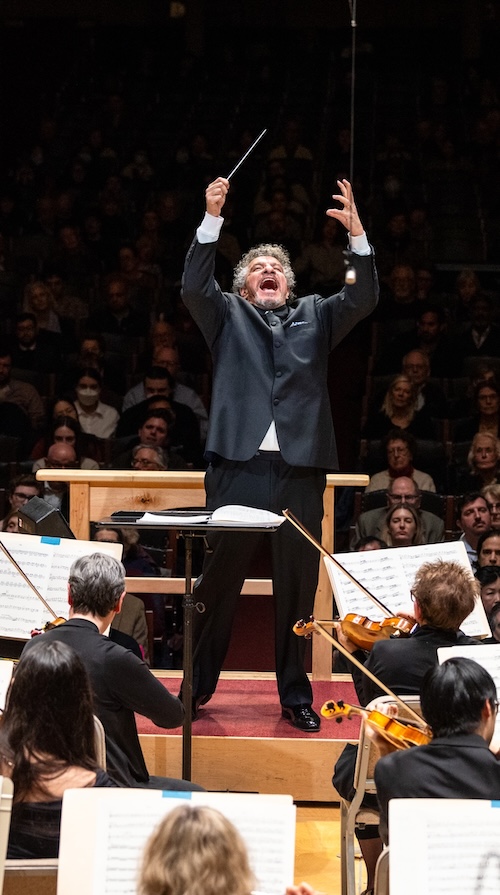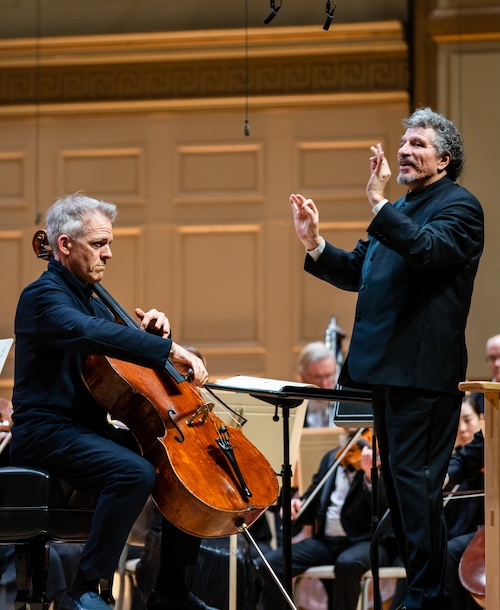Ortiz’s kaleidoscopic ballet proves a masterpiece with Guerrero and BSO

Giancarlo Guerrero conducted the Boston Symphony Orchestra premiere of Gabriela Ortiz’s Revolución diamantina Thursday night at Symphony Hall. Photo: Robert Torres
Some ballets, like The Rite of Spring, turn up on concert programs so frequently that it can be hard to imagine experiencing them in a theater. Gabriela Ortiz seems to have taken that reality to heart: her first entry in the genre, the Los Angeles Philharmonic-commissioned Revolución diamantina, has yet to be staged, though it boasts a thoroughly fleshed-out, six act scenario.
Even so, Revolución is making the rounds. Earlier this month, its debut recording took home a trio of Grammys, including the award for Best Contemporary Composition. Then, on Thursday, Giancarlo Guerrero led the Boston Symphony Orchestra in the work’s local premiere.
On the merits of that Symphony Hall performance, Revolución’s accolades are fully deserved. Ortiz’s score, which runs roughly forty minutes, is a masterpiece of color, rhythm, and spirit. Though it contains multitudes, it never loses sight of its larger, dancing goals. Along the way, the music visits any number of reference points: echoes of Revueltas, Copland, and Stravinsky emerge, as do—courtesy of an octet of amplified voices—John Adams, Philip Glass, and Steve Reich.
Except for rare occasions (like the pummeling allusion to Rite’s “Glorification of the Chosen One” at the end of Act 4), those nods are just that—reference points. Otherwise, Ortiz’s language is wholly her own: fresh, inventive, and ear-catching. In Revolución, the Mexican composer’s style bracingly serves a narrative that, in collaboration with the author Cristina Rivera Garza, celebrates her country’s “glitter revolution,” a recent, grassroots campaign protesting systemic violence against women.
Unfortunately, the finer details of Garza’s dramaturgy were obscured in Thursday’s performance, though that owed more to Ortiz’s through-composed approach to the form than any deficiency in the night’s account of the work. Still, one came away from the evening appreciating how a suite from Revolución might better serve the score in concert settings: as with most ballets, various sections would be enhanced by choreography.
Nevertheless, Guerrero, the BSO, and eight members of the Philadelphia-based choir The Crossing, gave Revolución their all. The orchestra’s percussion section, expanded to eight players for the night, acquitted itself admirably. Their lean, discreet moments near the beginning of Act 1 gleamed as much as the pounding riffs during Act 5’s thundering samba thrilled.
Though rhythmic, full-ensemble textures often took on a blunt sheen, Guerrero shaped Revolución’s lyrical moments thoughtfully. English hornist Robert Sheena’s playing in Act 2 was affectingly plangent, as was the string section’s sumptuous melodic climax to that section. Meanwhile, principal flute Lorna McGhee brought swooning, bluesy warmth to her Act 6 solos.
Members of The Crossing delivered their parts with brio, be they whispered, chanted, or sung. While the group’s amplification resulted in monodynamic impressions when the orchestra was playing softly, the score’s vocal effects—like Act 2’s bent notes and Act 5’s queasy slides—spoke potently. So did the collective’s contributions to the prayer-like final scene, whose pure-toned canons conveyed strength, resilience, and catharsis.

Alban Gerhardt performed Tchaikovsky’s Variations on a Rococo Theme with Giancarlo Guerrero and the BSO Thursday night. Photo: Robert Torres
More of the latter quality would have benefited Alban Gerhardt’s take on Tchaikovsky’s Variations on a Rococo Theme, which followed intermission. Back on a BSO subscription program for the first time since, shockingly, 1978, this cello-and-orchestra chestnut offers spades of great tunes and brio.
Though the German artist’s efforts here and in his encore of the Prelude from Bach’s Cello Suite No. 1 were never less than satisfactory, some skittish phrasings and edgy fingerwork suggested he was having an off night. Regardless, the Variations’ two slow sections reached beyond the routine to find places of inward repose
For their part, Guerrero and the orchestra were largely attuned to the score’s dynamic plays of contrast, especially those of tempo, mood, and character. The partnership also excelled in Francesca da Rimini, Tchaikovsky’s 1876 tone poem after Dante that was being assayed by the BSO for the first time since 2009.
Despite the sixteen-year hiatus, Thursday’s interpretation was eminently secure and balanced. The sensuous, shapely middle episode was highlighted by exquisite solos from several of the orchestra’s woodwind principals, particularly McGhee, Sheena, oboist John Ferrillo, and clarinetist William R. Hudgins. At the same time, Francesca’s blustery outer thirds were ever vigorous and often exhilarating.
In the usual course of events, those depictions of an endless hellish storm carry all before it. Thursday’s rendition certainly cranked up the decibels. But thanks to its close proximity to Revolución, one could leave Symphony Hall on this night for once optimistic that the title character, damned to eternal torment for following the passions of her heart, might find eventual vindication, if not outright redemption.
The program will be repeated 1:30 p.m. Friday and 8 p.m. Saturday at Symphony Hall. bso.org
Posted in Performances